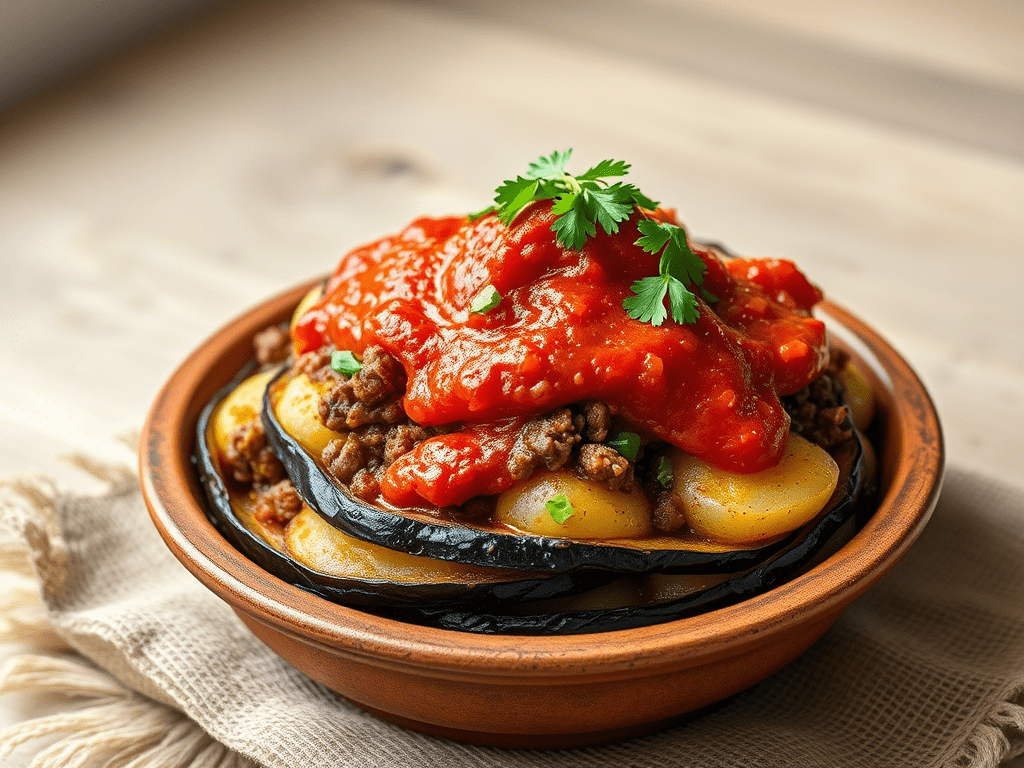5 Delicious Musakka Recipes You’ll Want to Make Again and Again
Few dishes capture the heart of comfort food quite like musakka. With layers of tender eggplant, savory meat, warm spices, and rich tomato sauce, it’s a meal that feels both rustic and elegant. Whether you’re discovering it for the first time or already a fan, this dish has countless variations worth exploring.
From the streets of Istanbul to family tables across the Mediterranean, musakka is more than just a recipe it’s a cultural experience. And while many associate it with the Greek-style version topped with béchamel, the Turkish and Middle Eastern versions offer their own unique twists.
In this article, we’ll dive into five mouthwatering musakka recipes some classic, some creative. You’ll learn the basics, the differences between regional styles, and how to prepare each version like a pro.
If you’re craving something warm, hearty, and satisfying, you’re in the right place.
Table of Contents
What Is Musakka?
At its core, musakka is a layered or blended dish built around eggplant, ground meat, and tomato, but it means something slightly different in every region where it’s served. It’s one of those recipes that has traveled across cultures and generations, adapting to local flavors along the way.
In Turkey, musakka (also spelled patlican musakka) is typically made in a pan, not the oven. The eggplant is usually fried until golden, then combined with sautéed ground meat, onions, tomatoes, and sometimes green peppers. The result is a juicy, oil-kissed dish with bold seasoning often served with rice or fresh bread.
The Greek version takes a different approach. There, musakka becomes a structured, layered casserole. You’ll find slices of eggplant stacked with meat sauce, topped with a thick layer of creamy béchamel. It’s baked in the oven until golden on top and firm enough to slice like lasagna. It’s the version most Westerners know, but far from the only one.
Meanwhile, moussaka turkey recipes may refer to the protein used (ground turkey) rather than the nationality offering a leaner, lighter version of the dish. It’s great for modern diets and people avoiding red meat.
And in the Middle East, musakka sometimes appears as a completely vegetarian dish often served cold with chickpeas, garlic, and olive oil. The ingredients are stewed rather than layered, and it’s more of a mezze than a main course.
So whether you’re cooking turkish moussaka, moussaka turkey, or a family version handed down for generations, the idea remains the same: celebrate eggplant, meat (or not), and bold Mediterranean flavor in a dish that brings people together.
Turkish vs Greek vs Arabic Versions
One of the most fascinating things about musakka is how a single concept takes on so many different forms across regions. While the core ingredients eggplant, tomato, and some form of protein stay fairly consistent, the preparation and presentation change dramatically depending on cultural tradition.
🇹🇷 Turkish Musakka
Known locally as patlican musakka, the Turkish version is perhaps the simplest in structure but richest in flavor. It’s typically made by pan-frying eggplant slices and layering them into a tomato-based ground meat sauce often seasoned with garlic, green peppers, and mild spices. There’s no béchamel, no layering in the oven. It’s assembled in one pan and cooked on the stove, giving it a juicy, rustic feel. It’s often served with plain rice or bulgur.
🇬🇷 Greek Moussaka
This version is all about layers. The eggplant is baked or fried, then stacked with spiced ground lamb or beef and finished with a thick layer of creamy béchamel sauce. It’s baked in the oven until golden on top and cut into slices like lasagna. It takes more time, but the result is luxurious and filling ideal for formal meals or Sunday dinners.
Arabic Moussaka
Across the Levant, musakka (or msakaa) often appears as a vegetarian stew. Eggplant is combined with chickpeas, onions, garlic, and tomato, then simmered until soft. It’s served cold or at room temperature as part of a mezze spread. The texture is softer, almost like ratatouille, and it emphasizes vegetables over meat or dairy.
Each style has its place. If you’re in the mood for something fast and hearty, the Turkish version wins. Want something creamy and indulgent? Go Greek. Craving something light and plant-based? Arabic musakka has your back.
Ingredients Breakdown – What You’ll Need
No matter which version of musakka you choose to make, there are a few core ingredients that show up again and again. Once you understand the basics, it’s easy to build your own twist on this iconic dish.
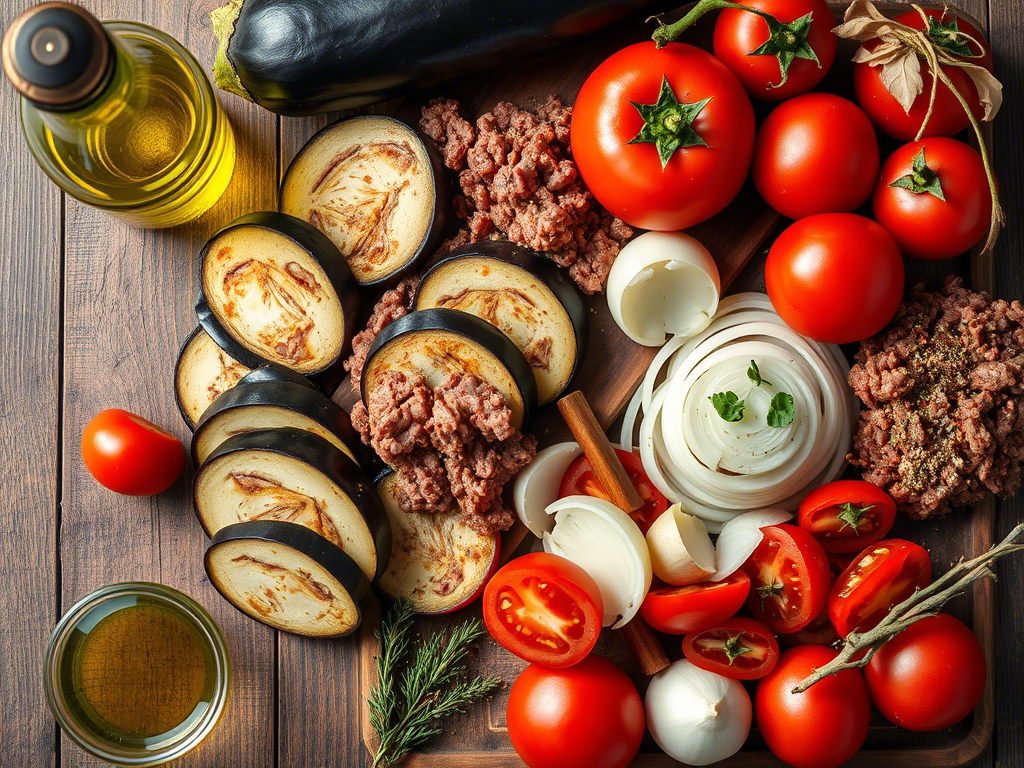
Vegetables
- Eggplant (Aubergine): The star of the show firm, ripe eggplant works best. Turkish versions often peel it in stripes and fry it.
- Tomatoes: Either fresh, peeled and diced, or canned crushed tomatoes.
- Onion & Garlic: For the base flavor in nearly all regional versions.
- Green Peppers (optional): Especially common in Turkish versions.
Protein
- Ground beef or lamb: Traditional, especially in Turkish and Greek musakka.
- Ground turkey or chicken: Lighter alternatives, great for modern recipes.
- Lentils or chickpeas: Ideal for vegetarian or Arabic styles.
Sauces & Extras
- Tomato paste: Adds depth to the sauce and helps it thicken.
- Spices: Paprika, black pepper, cumin, cinnamon (depending on the region).
- Béchamel sauce ingredients (Greek style): Butter, flour, milk, and nutmeg.
Once these elements are in place, making musakka is all about layering or mixing them in the right order and letting the flavors do the rest.
Musakka Recipe #1 – Classic Turkish-Style
This version of musakka is all about simplicity, rich flavor, and that signature Turkish comfort. No fancy layers, no béchamel just tender eggplant, juicy meat, and a rich tomato sauce cooked all together in one pan.
Ingredients:
- 2 medium eggplants, peeled in stripes and sliced
- 2 tablespoons vegetable oil (for frying)
- 1 onion, finely chopped
- 2 cloves garlic, minced
- 250g ground beef or lamb
- 2 medium tomatoes, diced
- 1 tablespoon tomato paste
- 1 green pepper (optional), chopped
- 1/2 teaspoon paprika
- Salt and pepper to taste
- 1/4 cup water
Instructions:
- Sprinkle the eggplant slices with salt and let them sit for 15–20 minutes. Rinse and pat dry.
- Fry the eggplant until lightly golden. Drain on paper towels.
- In a pan, sauté the onions and garlic until soft. Add ground meat and cook until browned.
- Stir in tomato paste, diced tomatoes, and green pepper. Add spices and water. Simmer for 5–10 minutes.
- Add the fried eggplant into the sauce or layer it gently. Simmer everything together for another 10–15 minutes.
- Serve warm with rice, bulgur, or fresh bread.
Pro Tip:
For a lighter version, you can roast the eggplant instead of frying it. Turkish style patlican musakka is often served with a spoon of yogurt on the side for balance.
Musakka Recipe #2 – Oven-Baked with Béchamel
If you’re looking for something heartier and more structured, this oven-baked musakka with béchamel is for you. Inspired by the Greek-style dish, it’s layered, rich, and perfect for serving guests or making ahead for the week.
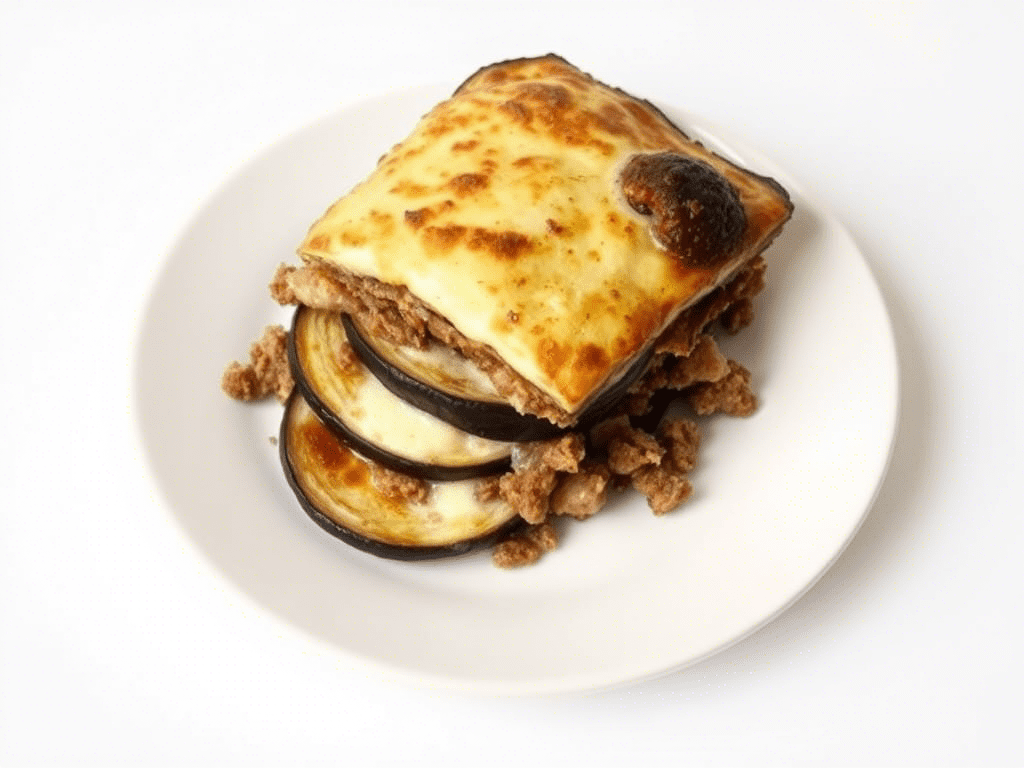
Ingredients:
For the base:
- 2 large eggplants, sliced into rounds
- 2 tablespoons olive oil
- 300g ground beef or lamb
- 1 onion, chopped
- 2 cloves garlic, minced
- 2 tablespoons tomato paste
- 1/2 teaspoon cinnamon
- Salt and pepper to taste
For the béchamel sauce:
- 2 tablespoons butter
- 2 tablespoons flour
- 1 1/2 cups milk
- Pinch of nutmeg
- 1 egg yolk (optional, for richness)
- Salt to taste
Instructions:
- Roast or lightly fry the eggplant slices until golden. Set aside.
- Sauté onion and garlic. Add meat, tomato paste, and spices. Cook until thick.
- In a saucepan, melt butter and whisk in flour. Gradually add milk and stir until thick. Season with nutmeg and salt. Stir in egg yolk if using.
- In a baking dish, layer eggplant, meat sauce, and béchamel. Repeat layers as needed, ending with béchamel.
- Bake at 180°C (350°F) for 30–35 minutes or until golden and set.
- Let it cool for 10 minutes before slicing.
Tip:
This musakka is best served with a crisp side salad or a glass of red wine. It keeps well in the fridge and can be reheated easily ideal for meal prep!
Musakka Recipe #3 – Light Vegetarian Version
If you’re skipping meat but still want something rich and satisfying, this vegetarian musakka hits the mark. It replaces ground meat with hearty ingredients like lentils or mushrooms, keeping the texture and depth without compromising on flavor.
This version is ideal for those following a plant-based diet, or anyone looking for a lighter option that still delivers comfort and warmth.
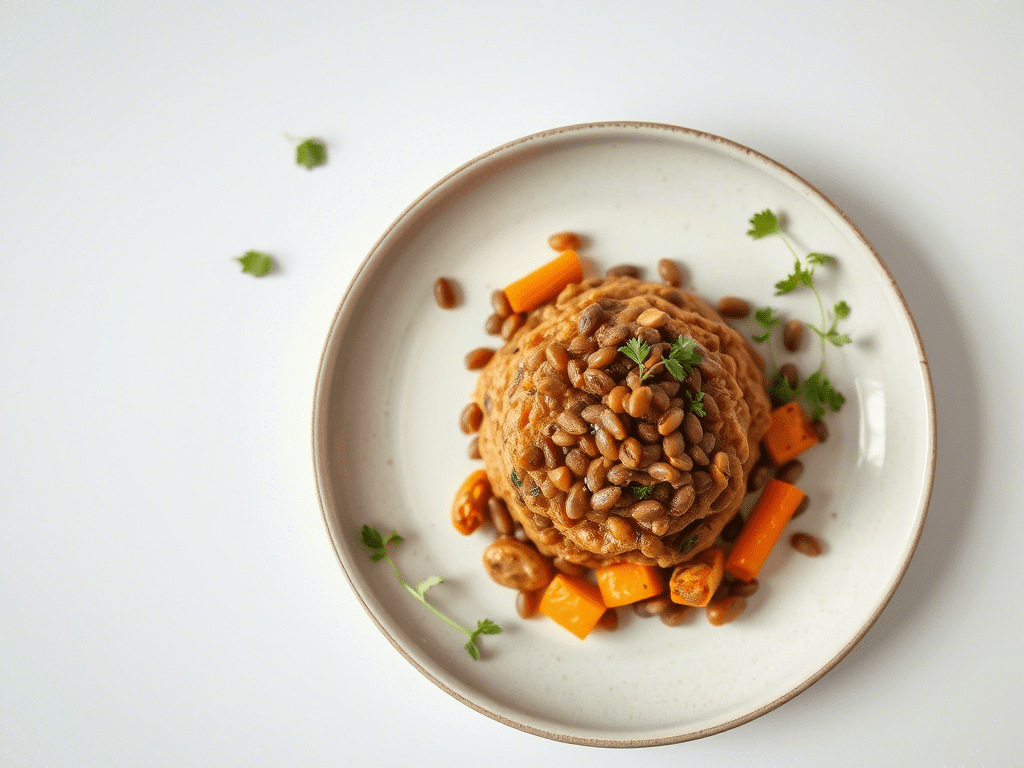
Ingredients:
- 2 large eggplants, sliced and roasted
- 1 can lentils (or 1 1/2 cups cooked green lentils)
- 1 onion, chopped
- 2 cloves garlic, minced
- 1 carrot, finely diced
- 1 zucchini (optional), diced
- 2 medium tomatoes or 1 can crushed tomatoes
- 2 tablespoons tomato paste
- 1 teaspoon cumin
- 1/2 teaspoon smoked paprika
- Salt and pepper to taste
- Olive oil for cooking
Instructions:
- Roast the eggplant slices until soft and slightly golden.
- In a large pan, heat olive oil and sauté onion, garlic, carrot, and zucchini.
- Add tomato paste and tomatoes. Simmer until thick.
- Stir in the lentils and season with spices. Let the filling cook down for 10 more minutes.
- In a baking dish, alternate layers of eggplant and lentil mixture. End with a tomato layer.
- Bake at 180°C (350°F) for 25–30 minutes. Rest before serving.
Tip:
You can add a layer of mashed potatoes or even dairy-free béchamel on top if you want extra creaminess. This musakka pairs well with couscous or a lemony herb salad.
Musakka Recipe #4 – One-Pot Weeknight Style
Busy night and still want something warm and filling? This one-pot musakka-style recipe simplifies the traditional approach into a weeknight-friendly dish you can make in under an hour. It skips the layers but keeps the soul of the original intact.
Instead of frying or baking, everything is cooked in one pan. The result is a cozy, rich, tomato-infused meal that brings comfort without the cleanup.
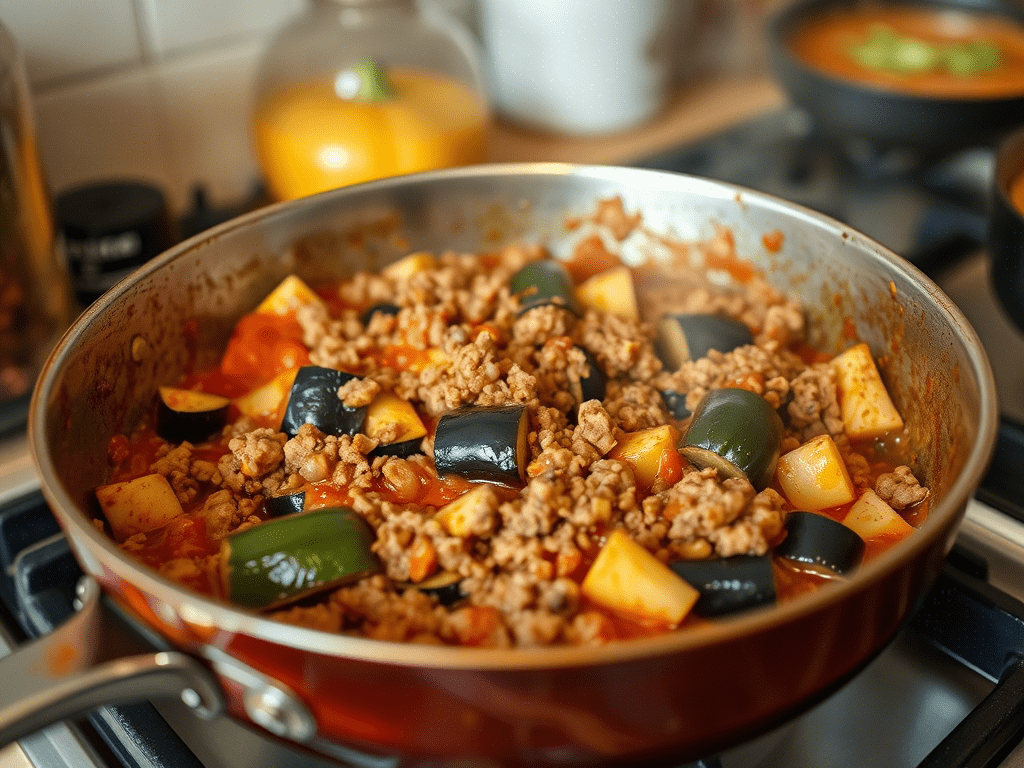
Ingredients:
- 2 eggplants, chopped into small cubes
- 1 onion, diced
- 2 cloves garlic, minced
- 250g ground beef or turkey
- 1 can crushed tomatoes
- 2 tablespoons tomato paste
- 1 teaspoon cumin
- 1/2 teaspoon dried mint or oregano
- Salt and pepper
- Olive oil for sautéing
- Optional: chili flakes for extra heat
Instructions:
- Heat olive oil in a deep skillet or pot. Add eggplant cubes and cook until soft and slightly browned. Remove and set aside.
- In the same pot, sauté onions and garlic. Add the meat and cook until browned.
- Stir in tomato paste, spices, and crushed tomatoes. Cook for 5 minutes.
- Return the eggplant to the pot and mix everything together. Simmer on low for 15–20 minutes until the sauce thickens and flavors meld.
- Adjust seasoning to taste and serve warm.
This dish is perfect with crusty bread, steamed rice, or even spooned over pasta. It’s everything you love about musakka with none of the fuss.
Musakka Recipe #5 – Spicy Turkey Moussaka
This version puts a bold, spicy twist on traditional musakka by using ground turkey and a touch of chili heat. It’s lighter than beef or lamb-based recipes but still full of flavor, making it a great choice for those looking to cut down on red meat without sacrificing taste.
Ground turkey absorbs seasoning really well and pairs beautifully with smoky paprika, chili flakes, and garlic. When layered with eggplant and tomato, the result is a dish that’s satisfying, energizing, and just spicy enough to keep things interesting.
Ingredients:
- 2 large eggplants, sliced and roasted
- 1 tablespoon olive oil
- 1 onion, finely chopped
- 2 garlic cloves, minced
- 300g ground turkey
- 1 tablespoon tomato paste
- 1 can chopped tomatoes
- 1 teaspoon smoked paprika
- 1/2 teaspoon chili flakes (or to taste)
- Salt and black pepper
- Optional: fresh parsley for garnish
Instructions:
- Roast or grill the eggplant slices until tender and slightly browned.
- In a large pan, heat olive oil and sauté the onion and garlic until soft.
- Add the ground turkey and cook thoroughly, breaking it up as it browns.
- Stir in tomato paste, chopped tomatoes, paprika, and chili flakes. Simmer until thick and rich.
- In a baking dish, layer the eggplant and turkey sauce. Repeat layers as needed.
- Bake at 180°C (350°F) for 25–30 minutes until bubbling and set. Let it rest before serving.
This spicy musakka turkey version is excellent with a dollop of yogurt or served alongside a crisp cucumber salad. It’s high in protein, lower in fat, and brings a modern, flavorful edge to a timeless dish.
Tips for Cooking Perfect Musakka
Even though musakka is a humble, homey dish, a few simple tips can elevate it from good to unforgettable. Whether you’re cooking Turkish-style in a pan or going full Greek with béchamel, here’s how to make sure it turns out just right.
Choose firm, ripe eggplants.
Avoid soft or overly seedy eggplants. Medium-sized ones with smooth skin are best—they’ll hold their shape and soak up flavor without becoming mushy.
Salt the eggplant before cooking.
This step helps reduce bitterness and prevents the vegetable from absorbing too much oil. Let the slices rest with salt for 15 to 30 minutes, then rinse and pat dry.
Cook the meat sauce until rich and thick.
Whether you’re using beef, turkey, or lentils, don’t rush the sauce. Simmer it long enough for the flavors to develop and for excess moisture to cook off.
Roast instead of fry for a lighter version.
If you’re watching calories or just prefer less oil, roasting eggplant slices in the oven gives a similar result without the grease.
Let baked versions rest before serving.
This helps the musakka set so it slices cleanly and holds its shape. Ten to fifteen minutes is usually enough.
Balance your spices.
Ground cinnamon, paprika, cumin, or mint, these can all enhance your dish when used in the right quantities. Don’t be afraid to taste and adjust as you go.
With just a few thoughtful steps, you’ll turn any musakka into a dish worth repeating. And the best part? The leftovers are even better the next day.
Common Mistakes to Avoid When Making Musakka
Even the most flavorful musakka recipes can fall flat if a few key steps are missed. Here are the most common mistakes people make, and how to avoid them for a delicious, balanced result every time.
Using undercooked or soggy eggplant
If the eggplant isn’t cooked enough before layering, it will taste chewy and absorb too much sauce. On the other hand, if it’s soaked in oil without proper draining, it can turn greasy. Always aim for golden and tender slices, whether roasted or fried.
Overloading the dish with sauce
Too much tomato sauce can make the musakka watery, especially in baked versions. The goal is a rich, concentrated filling, not a stew. Cook your sauce down and let excess moisture evaporate before assembling.
Skipping the salt-and-sweat step for eggplant
Salting the eggplant before cooking removes bitterness and prevents it from absorbing too much oil. This step makes a major difference in flavor and texture.
Cutting into the dish too soon
It’s tempting to dig in as soon as it comes out of the oven, but hot musakka needs time to set. Let it rest for at least 10 minutes so the layers hold and the flavor deepens.
Forgetting to slice against the grain (in Turkish styles)
If using strips of meat instead of ground meat, always slice against the grain. This makes each bite more tender and easier to chew.
Not tasting your sauce as you go
Musakka is flexible, but seasoning is key. Don’t be afraid to adjust your spices, add a splash of vinegar, or brighten it with a touch of lemon, your palate will thank you.
By avoiding these common pitfalls, you’ll not only improve the flavor and texture of your musakka, but you’ll also save yourself the frustration of ending up with a soggy or bland dish.
Musakka Final Thoughts + Internal Links + Amazon Picks
Musakka is more than just a dish, it’s a journey through culture, comfort, and flavor. Whether you prefer the rustic simplicity of Turkish patlican musakka, the structured elegance of a Greek oven-baked version, or a lighter vegetarian twist, there’s a version of musakka that fits your kitchen and lifestyle.
With the right techniques, good ingredients, and a few time-saving tips, you can make this dish a regular star on your dinner table. It’s satisfying, versatile, and even better the next day.
from GrowVibe
- Praline Pecans Recipe – Sweet & Crunchy
- Orange Creamsicle Cocktail – Refreshing & Fun
- London Broil Marinade – Flavorful Steak Recipes
Tools to Make Musakka Easier
- Nonstick Baking Dish – Ideal for layered musakka recipes
- Cast Iron Skillet – Great for stovetop Turkish versions
- Mandoline Slicer – For uniform eggplant slices
- Mesh Oil Strainer – To drain fried eggplant easily
- Mediterranean Cookbook – Inspiration for your next dish
Explore, experiment, and most importantly enjoy every bite. Your perfect musakka starts with one try.

